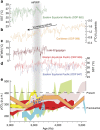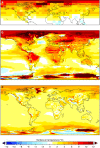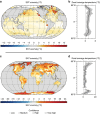Integrating geological archives and climate models for the mid-Pliocene warm period
- PMID: 26879640
- PMCID: PMC4757764
- DOI: 10.1038/ncomms10646
Integrating geological archives and climate models for the mid-Pliocene warm period
Abstract
The mid-Pliocene Warm Period (mPWP) offers an opportunity to understand a warmer-than-present world and assess the predictive ability of numerical climate models. Environmental reconstruction and climate modelling are crucial for understanding the mPWP, and the synergy of these two, often disparate, fields has proven essential in confirming features of the past and in turn building confidence in projections of the future. The continual development of methodologies to better facilitate environmental synthesis and data/model comparison is essential, with recent work demonstrating that time-specific (time-slice) syntheses represent the next logical step in exploring climate change during the mPWP and realizing its potential as a test bed for understanding future climate change.
Figures






Similar articles
-
On the identification of a Pliocene time slice for data-model comparison.Philos Trans A Math Phys Eng Sci. 2013 Sep 16;371(2001):20120515. doi: 10.1098/rsta.2012.0515. Print 2013 Oct 28. Philos Trans A Math Phys Eng Sci. 2013. PMID: 24043865 Free PMC article.
-
Polar amplification of Pliocene climate by elevated trace gas radiative forcing.Proc Natl Acad Sci U S A. 2020 Sep 22;117(38):23401-23407. doi: 10.1073/pnas.2002320117. Epub 2020 Sep 4. Proc Natl Acad Sci U S A. 2020. PMID: 32887804 Free PMC article.
-
Highly restricted near-surface permafrost extent during the mid-Pliocene warm period.Proc Natl Acad Sci U S A. 2023 Sep 5;120(36):e2301954120. doi: 10.1073/pnas.2301954120. Epub 2023 Aug 28. Proc Natl Acad Sci U S A. 2023. PMID: 37639595 Free PMC article.
-
Air quality research: perspective from climate change modelling research.Environ Int. 2003 Jun;29(2-3):253-61. doi: 10.1016/S0160-4120(02)00184-8. Environ Int. 2003. PMID: 12676212 Review.
-
Linking palaeoenvironmental data and models to understand the past and to predict the future.Trends Ecol Evol. 2006 Dec;21(12):696-704. doi: 10.1016/j.tree.2006.09.005. Epub 2006 Sep 26. Trends Ecol Evol. 2006. PMID: 17000023 Review.
Cited by
-
Regional restructuring in planktic foraminifera communities through Pliocene-early Pleistocene climate variability.Nat Commun. 2025 May 30;16(1):5056. doi: 10.1038/s41467-025-60362-8. Nat Commun. 2025. PMID: 40447598 Free PMC article.
-
Mitochondrial genomes of the European sardine (Sardina pilchardus) reveal Pliocene diversification, extensive gene flow and pervasive purifying selection.Sci Rep. 2024 Dec 28;14(1):30977. doi: 10.1038/s41598-024-82054-x. Sci Rep. 2024. PMID: 39730618 Free PMC article.
-
Enhanced intensity of global tropical cyclones during the mid-Pliocene warm period.Proc Natl Acad Sci U S A. 2016 Nov 15;113(46):12963-12967. doi: 10.1073/pnas.1608950113. Epub 2016 Oct 31. Proc Natl Acad Sci U S A. 2016. PMID: 27799528 Free PMC article.
-
Past terrestrial hydroclimate sensitivity controlled by Earth system feedbacks.Nat Commun. 2022 Mar 14;13(1):1306. doi: 10.1038/s41467-022-28814-7. Nat Commun. 2022. PMID: 35288559 Free PMC article.
-
Low CO2 levels of the entire Pleistocene epoch.Nat Commun. 2019 Sep 25;10(1):4342. doi: 10.1038/s41467-019-12357-5. Nat Commun. 2019. PMID: 31554805 Free PMC article.
References
-
- IPCC. Climate Change 2013: The Physical Science Basis Contribution of Working Group I to the Fifth Assessment Report of the Intergovernmental Panel on Climate Change (eds Stocker T. F.et al.. 1535Cambridge University Press (2013).
-
- Valdes P. Built for stability. Nat. Geosci. 4, 414–416 (2011).
-
- Raymo M., Grant B., Horowitz M. & Rau G. Mid-Pliocene warmth: stronger greenhouse and stronger conveyor. Mar. Micropaleontol. 27, 313–326 (1996).
-
- Kürschner W. M., van der Burgh J., Visscher H. & Dilcher D. L. Oak leaves as biosensors of late Neogene and early Pleistocene paleoatmospheric CO2 concentrations. Mar. Micropaleontol. 27, 299–312 (1996).
-
- Seki O. et al.. Alkenone and boron-based Pliocene pCO2 records. Earth Planet. Sci. Lett. 292, 201–211 (2010).
Publication types
LinkOut - more resources
Full Text Sources
Other Literature Sources
Miscellaneous

